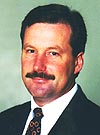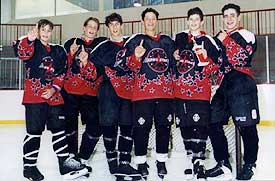Pioneers Finally Feel “On Track”
They began the year in a position they’d never seen before. Entering the 2002-03 campaign the Sacred Heart Pioneers were no longer in their comfortable, though sometimes frustrating, position of underdog.
As a team that has been up-and-coming for three years now, experts believed that the Pioneers were finally ready to reach their peak this season, laden with stronger senior forwards and senior netminder Eddy Ferhi between the pipes.
But then the problems started to arise. Faced with a tough five-game road schedule to start the season, Sacred Heart emerged without a win, mustering only two road ties at Bemidji State to start the year.
“We had a tough schedule right off with all the travel,” said head coach Shaun Hannah. “We went out to Bemidji and did well there and thought that was a successful trip.
“Then [we played] two games at Colgate and we played solid both nights. I was pleased with our effort but disappointed we didn’t get a win.”
Two one-goal losses to an establish ECAC team coupled with the two ties to Bemidji still had hopes high for the Pioneers. Until, that was, a trip to Canisius in week three.
“Out at Canisius it was our fifth road game on a row,” Hannah said of a game that saw his club lose a third-period lead and fall, 3-2, in overtime. “We played okay but had a couple of defensive breakdowns that cost us.”
So entering last weekend’s action, one thing was clear: the Pioneers would not only have to “play okay,” they needed to win.
That’s exactly what they did, beating Army last Friday, 3-1, before winning a Tuesday night matchup with Bentley handily, 5-2.
According to Hannah, those wins were exactly what the doctor ordered.
“[Tuesday] night’s win and Friday’s win against Army helped us the most,” said Hannah. “Our team has gotten better every game. We’ve got freshmen on every line so it takes some time to get them acclimated.”
Despite possessing a 2-3-2 record at this juncture, Hannah feels his team has taken care of at least one end of the ice: defense. Now the question is, with a five-goal outburst at Bentley, has the offense finally awakened?
“Defensively we’ve played fantastic,” Hannah noted about a club defense that ranks tops in the MAAC, allowing just 2.29 goals per game overall and a stingier 2.00 goals against in league games. “We have had some trouble putting puck in the net. But it’s just a matter of our forwards generating some shots and going to the net. It’s an area that still needs to improve but it will come.”
To continue to find the bright side to the slow start, Hannah just has to look to special teams. His power play has executed at a 40 percent success rate in the league while shorthanded the team’s three man-down tallies in seven games are already highlight material.
When asked if his team felt more pressure this year with higher expectations, Hannah candidly admitted it is on his club’s mind.
“We discussed [the pressure] as a team and we are in a position this year we’ve never been in,” Hannah said. “We’re not the underdog going into every game. Changing our focus and making that adjustment is something we have to do.
“It’s pressure but it’s a pressure that [the players] want. You don’t want to be the underdog all the time. We’ve made some good progress here and now we need to use that pressure to perform.”
The player with possibly the highest hype and thus the most pressure is Ferhi. In his senior year, the netminder is finally regarded as one of the tops in a league filled with good goaltending.
Hannah feels, though, that he’s already proven he’s ready for the challenge.
“I think [Ferhi’s] looking to have a big year,” said Hannah. “He knows going into every game that his job is to give our team a chance to win.
“He’s always done that for us and he’s kept us in some games this year. This is an opportunity for him to rise to the top and he’s ready for that too.”
Now the challenge for the Pioneers is to continue winning ways and climbing up the league standings early in the season rather than later. That all starts this weekend with a two-game series against Connecticut.
“Traditionally in the past our games with UConn have been good games,” Hannah said. “UConn has a character team and they always have. Even if you’re ahead you can’t let your guard down.”
That sounds like advice that will be important through the season for the Pioneers to enjoy their much-anticipated success.
Weekly Awards
ITECH MAAC Hockey League Player of the Week: Matt Craig, Quinnipiac, London, ON
Craig tallied his first career hat trick in the Bobcats’ 9-3 win over AIC on Friday night. Trailing 3-2 late in the second period, he ignited the comeback with the tying goal, then added the game-winner later in the frame. He completed the feat with a marker in the third period. For the season, Craig ranks at the top of the MAAC in goals (10) and points (16).
ITECH MAAC Hockey League Co-Goalies of the Week:
Simon St. Pierre, Bentley, Montreal, QU
In a two-win weekend, second-year netminder St. Pierre collected 61 saves, including 38 against Army in a 4-2 win. He relinquished just three goals over the weekend, bringing his GAA to 3.15, with a .903 SV%, and 196 saves. With two wins over the weekend, it marks the first two-game road sweep since 1998, and the first ever for Bentley in Division I competition.
Matt Cifelli, Mercyhurst Toronto, ON
Cifelli played both games in goal for Mercyhurst and stopped a combined 56 of 59 shots (.949). He stopped 36 of 38 UConn shots Saturday as the Huskies outshot the Lakers 38-32. The Lakers went a combined 5-for-9 (.556) on the power play over the weekend and killed all 12 opponent chances.
ITECH MAAC Hockey League Rookie of the Week: Jake Plattner, Bentley, Millserville, MD
In a two-win weekend the first-year forward collected two goals against Army and added a helper against Iona. His second goal against Army proved to be the game-winner. Bentley’s win at Army was the first ever win in West Point, a span of 12 games.
Bentley Flies High On Road
It was five long years that Bentley College could go on the road for a weekend with a guarantee to come home with at least one thing: a loss.
That ended last weekend as the upstart Falcons — whose coach, Ryan Soderquist, was a player for Bentley the last time they won two on the road in a weekend — swept by knocking off Iona on Friday night, 3-1, and Army on Saturday night, 4-2.
“I don’t remember the last time we swept [a weekend] on the road,” laughed Soderquist. “Heck, I can’t remember the last time we won back-to-back games. It’s was good for the young guys to see that we can win in the league.
A team that is averaging eight or nine freshmen in the lineup each night, the Falcons are gaining the confidence that first-year coach Soderquist, an assistant under previous head coach Jim McAdam for two years, hoped for.
“Even last year, we lost a lot of games, but we were in losing them late in the game,” said Soderquist. “We just never got the confidence that we could win games.
“This year, even with a young team, we have the confidence that if we stick to our game plan and play our game, we will win the games.”
Much of the success can be credited to the play of Simon St. Pierre. The sophomore netminder struggled through his freshman season but has shown improvement enough to be the MAAC co-goalie of the week.
“Over the weekend St. Pierre played great hockey,” Soderquist said. “[Tuesday in a 5-2 loss to Sacred Heart] he didn’t play as well, but I spoke with him. It was important that he realized [for himself] that he should’ve had a couple of goals.”
One thing Soderquist is trying hard to implement is a system of discipline. As a player, he was known for not only a good scoring touch but a fiery attitude that earned him plenty of penalty minutes. That, though, is not what he wants to see carry over now that he’s head coach.
“We played Fairfield at home and we had 14 penalties,” said Soderquist. “So we had a team meeting and got things together. [Tuesday] we had only two [minutes], so that’s an improvement.
“We’re not a team that can afford to not have five guys on the ice.”
A team that hasn’t finished high enough for the playoffs since its inaugural year in the MAAC, Soderquist is enthused that his club is not only winning, but showing hunger in getting those wins.
“It was good to see us win two games back-to-back,” Soderquist said. “We weren’t satisfied with just the win on Friday night. We wanted both games.”
Connecticut Challenge, Part I
As part of an agreement with the Arena at Harbor Yard in Bridgeport, Conn., college hockey will be on showcase this weekend in southern Connecticut.
Four Connecticut-based teams — Fairfield, Connecticut, Sacred Heart and Quinnipiac — will showcase college hockey at the barn that houses the AHL’s Bridgeport Sound Tigers this Friday night. Action begins at 5 p.m. with Sacred Heart taking on Connecticut. Quinnipiac will face Fairfield in the nightcap at 8.
The event is the first of two nights that will highlight college hockey at the recently-built pro hockey palace. Three of the four schools – excluding Quinnipiac and adding Iona — will again play a two-game, single-night showcase on March 6, 2003.
The challenge of the weekend will be attendance. In a league where the average attendance is already very low, the 8,500-seat Arena at Harbor Yard would seem like a church without a large handful of fans in the seats. The regular tenant, the Tigers, has had trouble already this season generating fan support, averaging only 4,061 fans per game — 24th in a 28-team league.
According to Sacred Heart’s Shaun Hannah, each individual team will have the responsibility for filling the arena on Friday.
“We’ve drawn well from the local community here,” said Hannah, whose club drew 658 fans to its home opener last Friday. “[Attendance] is dependent on what each school has done in terms of selling tickets.
“We’ve been real aggressive getting out into the community. It’s a real good chance for us to showcase our sport and the level of play in the league.”
Of the four teams playing Friday night, Quinnipiac has the highest attendance, averaging 1,029 in three home games. UConn is second with an 924 per home date. The aforementioned Sacred Heart and Fairfield each have had one game, with Fairfield attracting only 457 to its home opener.
Hard-luck Iona Adjusting To Road
The start of this season hasn’t been what Iona and head coach Frank Bretti hoped for. Faced with a daunting nonleague schedule and a lineup comprised almost entirely of underclassmen, Bretti pulled no punches early in the year, noting that his team had an uphill climb.
But he likely never believed that his club would fall winless through its first nine games before facing the toughest part of its schedule.
“A lot of the bounces aren’t going our way right now,” said senior goaltender Mike Fraser. “You can tell in the dressing room that guys are frustrated but, at the same time, everybody knows we put in a good effort [against AIC (a 2-1 loss)]. We just have to build on that — especially now that we go on the road.”
“On the road” may be an understatement. The Gaels play 13 of their next 16 games that way, with home contests against Fairfield, Quinnipiac and Sacred Heart sandwiched. Included in that stretch will be nonleague games against Massachusetts, Union, and nationally-ranked Maine (10) and Brown (15).
Fraser, though, is hoping this can build chemistry in the young team.
“We jelled a little bit [in a two-game set at Alaska-Anchorage]. We’re underdogs this year and that’s the way it is right now. We have to use that to our advantage. We have to go [on the road trips] with a clean slate and work our butts off,” Fraser said.
Bretti feels that the team will need to see the silver lining in the task ahead.
“We have to try to turn it onto a positive,” said Bretti. “On the other side of the coin, you are going on the road and going up against teams in their own building [and] the odds are in their favor.
“Somehow or another, we have to turn this thing around and try to keep our distraction down to a minimum.”
Over the course of the season, Iona will play the toughest nonleague schedule in the MAAC. That’s something that Bretti arranged by design and hoped could help his team. But nine games into the season, he may be questioning that philosophy.
“It’s hard to say. The rationale behind the setting of our schedule was to go up against some teams that were going to limit our time and space to do things and bring that quickness to the MAAC. It almost seems like it backfired on us,” said Bretti.
Still looking for a positive, Bretti believes that as the season goes on, the schedule will begin to work to Iona’s favor.
“I think our guys, from a hockey standpoint, will be a little more ready for the games than in the beginning [of the season].”
Thanks to Anthony Mastantuoni for his contributions




